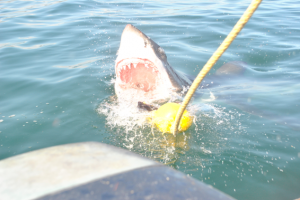A First, Second, and Eighth Encounter
Posted by Brenna Padgett on February 13, 2012
The ocean is an amazingly beautiful and complicated place where creatures great and small have evolved amazing adaptations difficult to understand for Homo sapiens.
Growing up landlocked in the Midwest, the Great White Shark had always seemed like a mythical creature that only showed it’s glowing white teeth and amazing power when surfers were present, or there was a rogue shark being hunted down and slaughtered for having a taste for humans. As a prospective scientist with an interest in these amazing creatures, however, I knew that there had to be a reason for these attacks and that the Great White Shark was so much more than the media made it out to be. I could not pass up the opportunity to learn as much as I could about White Sharks and their relatives, and participate in the current research being conducted. That’s how I found myself as an intern for Oceans-Research.
The challenges of research in the ocean are undeniable. Finding, documenting, and identifying individuals take a team effort, and a lot of work. It’s important to have a working boat (even if it’s not a luxury yacht), an upbeat attitude, and a lot of patience. Education goes a long way, and by learning everything we can and sharing this knowledge outside of the scientific community, the Great White Shark has a bright future. But why would someone want to conserve and protect the frightening, hideous sea monster they show on television?
This is a question I’m sure many will ask in my future, and the only way I know how to answer it is to describe my first day on the chum boat. It was my birthday, and the sea was a beautiful blue green as we climbed aboard the Lamnidae. Although I knew I was going to see my first Great White in the wild, I didn’t exactly know what to expect. As we arrived at the site, we all chose jobs. I got the all-important job of taking photos of the dorsal fin of each shark we saw so that we could identify the shark later for population and abundance assessments. As a lookout called down that there was a shark at 3 o’clock, I looked over the side and saw the most amazing thing I’ve ever seen. It was a massive shadow moving slowly, passively along the side of our boat, and as it came closer I could see every scratch, scrape, scar, and marking on the massive creature. It came close, lazily bumped the bait, and slowly turned downward and disappeared. Not only had I seen my first white shark, but it was incredibly graceful, elegant, and magnificent.
As the morning wore on, we ended up seeing eight sharks. Although not a record for one day, I’ve learned that seeing eight sharks on one trip is rare. Some were quite aggressive at the bait, while others didn’t even surface to investigate. Each definitely had its own personality, and as we drove away, all I could think of was the power, grace, and enormous misunderstanding that many have of the Great White Shark.
A brand new appreciation and respect for the research and conservation of this apex predator has been planted within my brain, and thousands of questions that have yet to be answered to go along with it. It’s hard not to realize that the ocean is this curious animal’s home, and we are the ones that enter into unfamiliar habitat. If we are able to understand more about the creature, it’s possible that this can raise awareness and allow humans to accept responsibility for entering into shark habitat, the ocean, just like entering a forest requires respect and awareness of the apex predators living there (such as bears and mountain lions). Hopefully this understanding will allow for shark conservation, so that these magnificent animals aren’t lost from this world forever at the hands of Homo sapiens.
